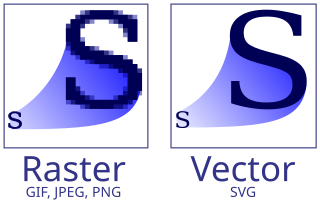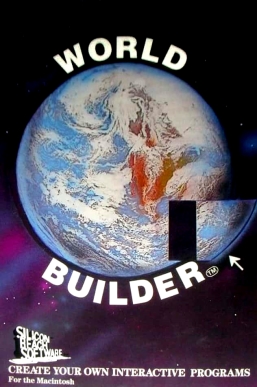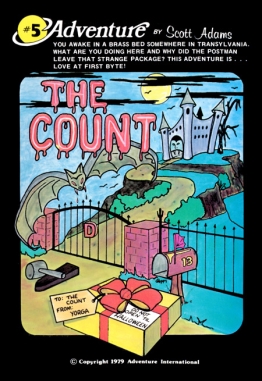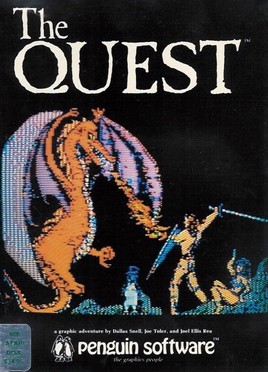
A graphical user interface, or GUI, is a form of user interface that allows users to interact with electronic devices through graphical icons and visual indicators such as secondary notation. In many applications, GUIs are used instead of text-based UIs, which are based on typed command labels or text navigation. GUIs were introduced in reaction to the perceived steep learning curve of command-line interfaces (CLIs), which require commands to be typed on a computer keyboard.
Interactive fiction (IF) is software simulating environments in which players use text commands to control characters and influence the environment. Works in this form can be understood as literary narratives, either in the form of Interactive narratives or Interactive narrations. These works can also be understood as a form of video game, either in the form of an adventure game or role-playing game. In common usage, the term refers to text adventures, a type of adventure game where the entire interface can be "text-only", however, graphical text adventure games, where the text is accompanied by graphics still fall under the text adventure category if the main way to interact with the game is by typing text. Some users of the term distinguish between interactive fiction, known as "Puzzle-free", that focuses on narrative, and "text adventures" that focus on puzzles.

Vector graphics are a form of computer graphics in which visual images are created directly from geometric shapes defined on a Cartesian plane, such as points, lines, curves and polygons. The associated mechanisms may include vector display and printing hardware, vector data models and file formats, as well as the software based on these data models. Vector graphics are an alternative to raster or bitmap graphics, with each having advantages and disadvantages in specific situations.
An audio game is an electronic game played on a device such as a personal computer. It is similar to a video game save that there is audible and tactile feedback but not visual.
An interactive film is a video game or other interactive media that has characteristics of a cinematic film. In the video game industry, the term refers to a movie game, a video game that presents its gameplay in a cinematic, scripted manner, often through the use of full-motion video of either animated or live-action footage.

Real-time computer graphics or real-time rendering is the sub-field of computer graphics focused on producing and analyzing images in real time. The term can refer to anything from rendering an application's graphical user interface (GUI) to real-time image analysis, but is most often used in reference to interactive 3D computer graphics, typically using a graphics processing unit (GPU). One example of this concept is a video game that rapidly renders changing 3D environments to produce an illusion of motion.

Moonmist is an interactive fiction game written by Stu Galley and Jim Lawrence and published by Infocom in 1986. The game was released simultaneously for the Amiga, Amstrad CPC, Apple II, Atari 8-bit computers, Atari ST, Commodore 64, MS-DOS, TRS-80, TI-99/4A, and Mac. It is Infocom's twenty-second game. Moonmist was re-released in Infocom's 1995 compilation The Mystery Collection, as well as the 1996 compilation Classic Text Adventure Masterpieces.

The Hobbit is an illustrated interactive fiction video game released in December 1982 for the ZX Spectrum home computer. Based on the 1937 book The Hobbit, by J. R. R. Tolkien, it was developed at Beam Software by Philip Mitchell and Veronika Megler and published by Melbourne House. It was converted the Commodore 64, BBC Micro, Oric, and other home computers. By arrangement with the book publishers, a copy of the book was included with each game sold.
Pre-rendering is the process in which video footage is not rendered in real-time by the hardware that is outputting or playing back the video. Instead, the video is a recording of footage that was previously rendered on different equipment. Pre-rendered assets may also be outsourced by the developer to an outside production company. Such assets usually have a level of complexity that is too great for the target platform to render in real-time.

World Builder is a game creation system for point-and-click text-and-graphics adventure games. It was released for Macintosh in 1986 by Silicon Beach Software and had already been used for creating Enchanted Scepters in 1984. On August 7, 1995, developer William C. Appleton released World Builder as freeware.

Twin Kingdom Valley is a text adventure game with animated pictures for the BBC Micro, Acorn Electron, Commodore 64, Commodore 16, and ZX Spectrum. It was released in 1983 by Bug-Byte.

The Count is a text adventure written by Scott Adams and published by Adventure International in 1979. The player character has been sent to defeat the vampire Count Dracula by the local Transylvanian villagers, and must obtain and use items from around the vampire's castle in order to defeat him.

SwordThrust is an interactive text adventure game for the Apple II, created by Donald Brown and published by CE Software in 1981. It consists of seven separate adventures and is the commercial successor to Brown's Eamon (1980).

Obsidian is an action-adventure computer game for the Amstrad CPC personal computer published by Artic Computing in 1986. The game is set on the titular space station located within the centre of an asteroid, which is out of control and drifting towards a black hole. The player must guide an astronaut with a jet pack around the station and re-activate its engine shields to prevent the Obsidian's destruction. This involves collecting items and using them to solve puzzles, while avoiding the Obsidian's reactivated security systems.

Star Wars: TIE Fighter is a 1994 Star Wars space flight simulator and space combat video game, a sequel in the Star Wars: X-Wing series. It places the player in the role of an Imperial starfighter pilot during events that occur between The Empire Strikes Back and Return of the Jedi.
A variety of computer graphic techniques have been used to display video game content throughout the history of video games. The predominance of individual techniques have evolved over time, primarily due to hardware advances and restrictions such as the processing power of central or graphics processing units.
An adventure game is a video game genre in which the player assumes the role of a protagonist in an interactive story, driven by exploration and/or puzzle-solving. The genre's focus on story allows it to draw heavily from other narrative-based media, such as literature and film, encompassing a wide variety of genres. Most adventure games are designed for a single player, since the emphasis on story and character makes multiplayer design difficult. Colossal Cave Adventure is identified by Rick Adams as the first such adventure game, first released in 1976, while other notable adventure game series include Zork, King's Quest, Monkey Island, Syberia, and Myst.

The Quest is a graphic fantasy text adventure released in 1983 by Penguin Software. It was designed by Dallas Snell for the Apple II and was ported to the Atari 8-bit computers, Commodore 64, MS-DOS, and Mac.
Tcl is a high-level, general-purpose, interpreted, dynamic programming language. It was designed with the goal of being very simple but powerful. Tcl casts everything into the mold of a command, even programming constructs like variable assignment and procedure definition. Tcl supports multiple programming paradigms, including object-oriented, imperative, functional, and procedural styles.

Microsoft Adventure is a interactive fiction game published in 1979 by Microsoft for the TRS-80 and Apple II, then released in 1981 by IBM for the IBM PC. It is based on the PDP-10 mainframe game Colossal Cave Adventure. It was programmed for Microsoft by Gordon Letwin of Softwin Associates.













